Header

1: Home page
2: Search page
3: About page
4: Help page
5: Contact page
Search page
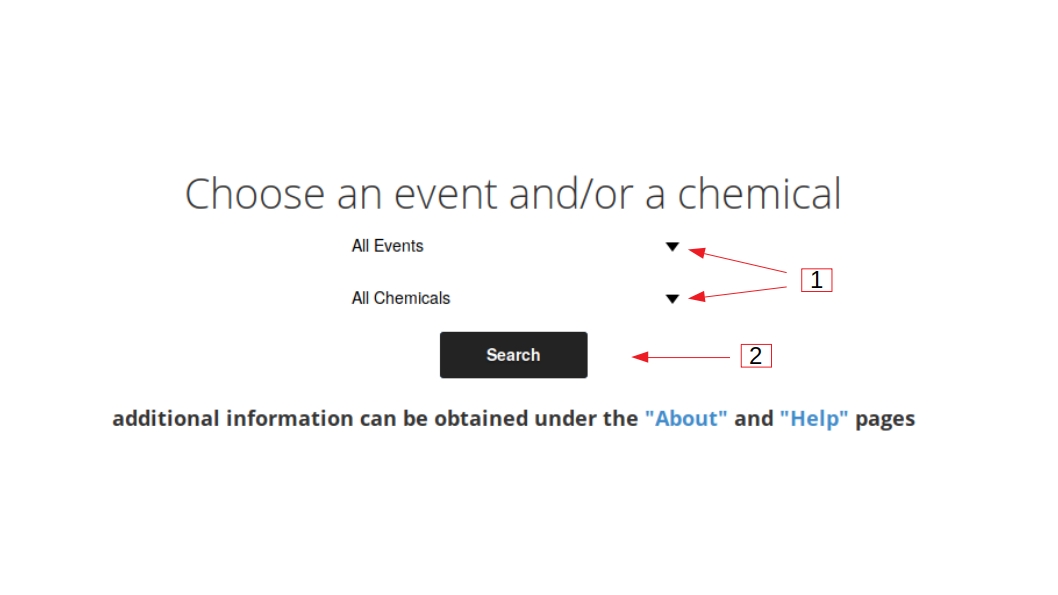
1: Choose an event and or a chemical. If you leave blank you will have all the database. You can type or check the list.
2: Click here to search.
Result page
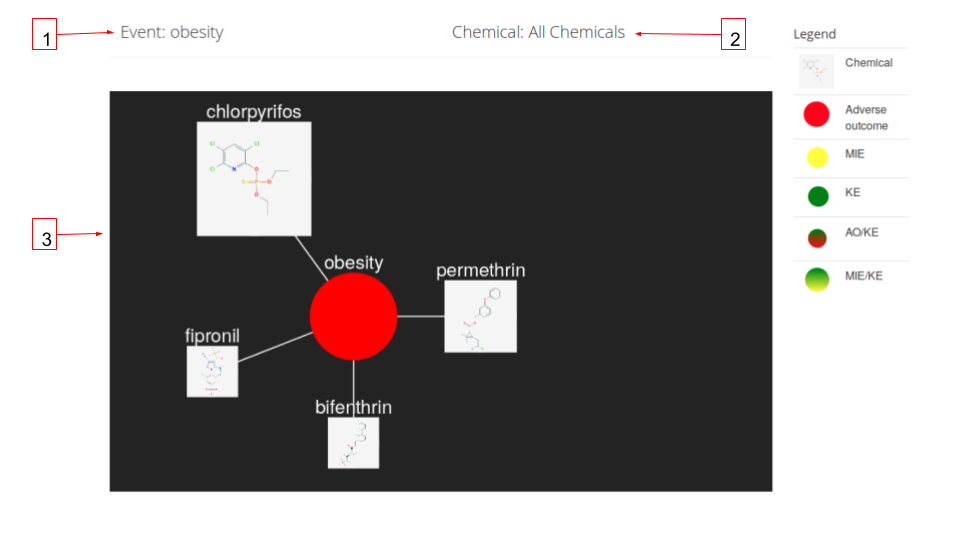
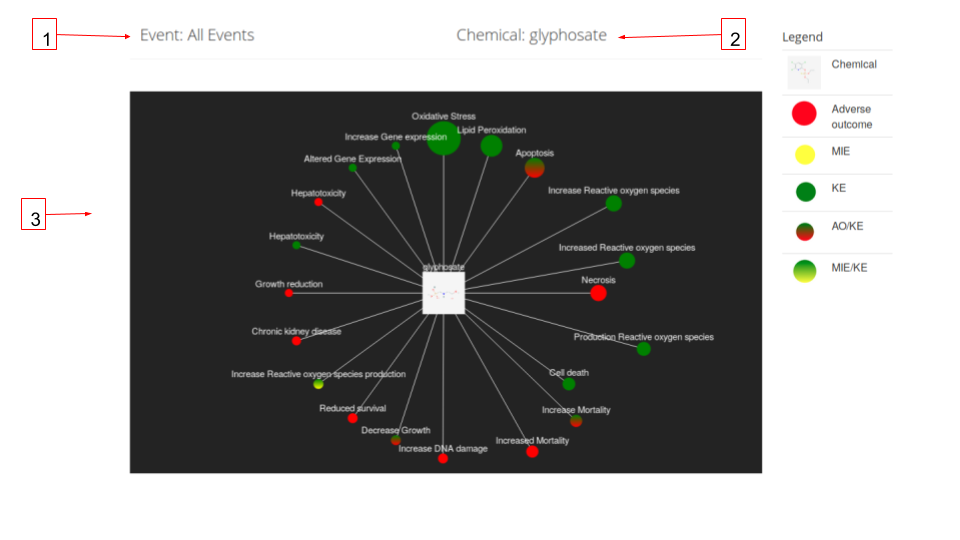
1 & 2: Reminder of your choices.
3:Network visualization of the results from your search. The square nodes represent the chemicals, the round nodes the events. The colors correspond to the types of events. For clarity, only the top 20 events/chemicals are depicted, according to the number of evidence retrieved in the literature. On the top of the network, results with the most evidence are represented, followed by other results will less evidence (clockwise direction). The size of the nodes is according to the number of abstracts identified by text mining (Warning you can't compare two different results). The network is interactive, meaning that nodes can be moved, to have a better visualization of the results. By clicking on a chemical, the corresponding PubChem database page will appear. Clicking on one event will open the corresponding AOP-wiki page.
If a MIE and a KE have the same identifier in the AOP-wiki database (ex. Apoptose'), they are represented only once with a bi-colored node (or in one line in the result table). This reflect the information provided by the AOP-wiki database: an event can be defined as a MIE in one AOP, and the same event can also be defined as a KE in another AOP. Same with KE/AO.
If two events have the same name, as 'hepatotoxicity', and are present in the AOP-wiki database under two different identifiers (and event types), they will appear with two different nodes (or two lines in the result table).
Table of results
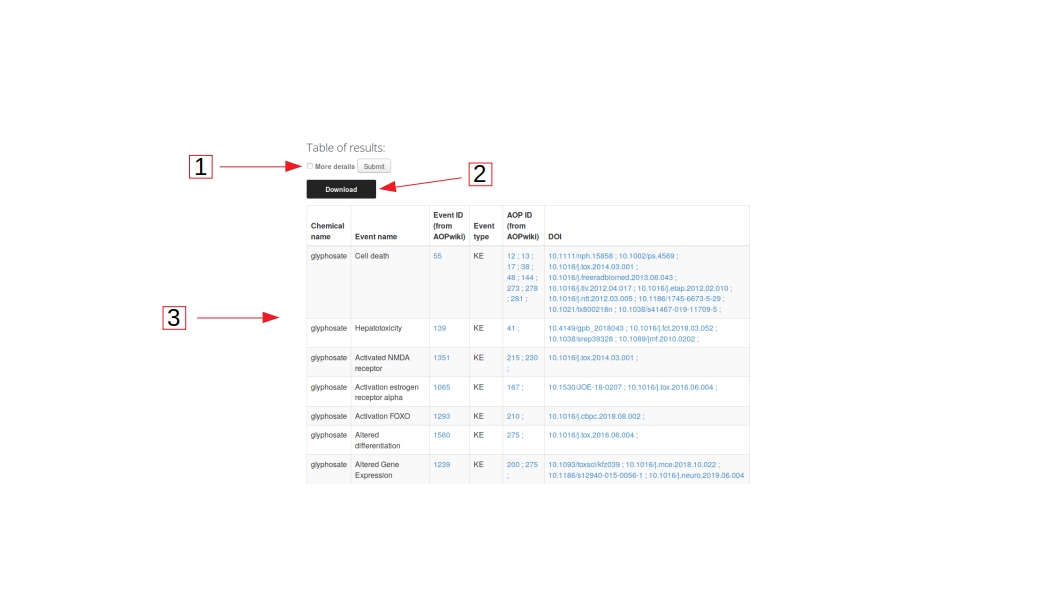
1: More details about your results (chemical, event name, event type, AOP-wikiID, DOI, abstract title)
2: To download in a .csv format all the results of your search
3: Table with the results:
- if you search for an event, the table includes:
- The list of chemicals linked to the event
- The list of abstracts (DOI)
- if you search for a chemical, the table includes:
- The name of the chemical
- The list of events found (name, AOP-wikiID, event type)
- The list of the corresponding AOP (AOP-wikiID)
- The list of abstracts (DOI)
2: Click here to search.
Result page


1 & 2: Reminder of your choices.
3:Network visualization of the results from your search. The square nodes represent the chemicals, the round nodes the events. The colors correspond to the types of events. For clarity, only the top 20 events/chemicals are depicted, according to the number of evidence retrieved in the literature. On the top of the network, results with the most evidence are represented, followed by other results will less evidence (clockwise direction). The size of the nodes is according to the number of abstracts identified by text mining (Warning you can't compare two different results). The network is interactive, meaning that nodes can be moved, to have a better visualization of the results. By clicking on a chemical, the corresponding PubChem database page will appear. Clicking on one event will open the corresponding AOP-wiki page.
If a MIE and a KE have the same identifier in the AOP-wiki database (ex. Apoptose'), they are represented only once with a bi-colored node (or in one line in the result table). This reflect the information provided by the AOP-wiki database: an event can be defined as a MIE in one AOP, and the same event can also be defined as a KE in another AOP. Same with KE/AO.
If two events have the same name, as 'hepatotoxicity', and are present in the AOP-wiki database under two different identifiers (and event types), they will appear with two different nodes (or two lines in the result table).
Table of results

1: More details about your results (chemical, event name, event type, AOP-wikiID, DOI, abstract title)
2: To download in a .csv format all the results of your search
3: Table with the results:
- if you search for an event, the table includes:
- The list of chemicals linked to the event
- The list of abstracts (DOI)
- if you search for a chemical, the table includes:
- The name of the chemical
- The list of events found (name, AOP-wikiID, event type)
- The list of the corresponding AOP (AOP-wikiID)
- The list of abstracts (DOI)
2: To download in a .csv format all the results of your search
3: Table with the results:
- if you search for an event, the table includes:
- The list of chemicals linked to the event
- The list of abstracts (DOI)
- if you search for a chemical, the table includes:
- The name of the chemical
- The list of events found (name, AOP-wikiID, event type)
- The list of the corresponding AOP (AOP-wikiID)
- The list of abstracts (DOI)
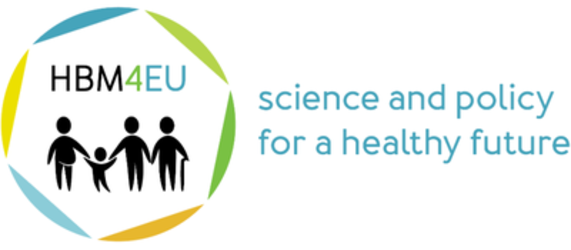
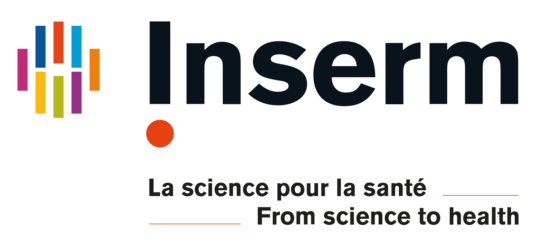
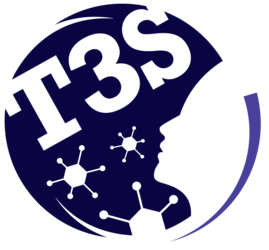

 The HBM4EU project has received funding from the European Union's Horizon 2020 research and innovation programme under grant agreement No 733032.
The HBM4EU project has received funding from the European Union's Horizon 2020 research and innovation programme under grant agreement No 733032.